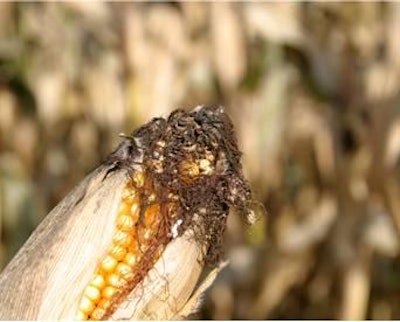
The term "mycotoxin" is derived from “mykes,” meaning fungi, and “toxicon,” meaning poison. Mycotoxins are secondary metabolites of low molecular weight produced by a wide range of fungi species, e.g., Aspergillus, Penicillium and Fusarium sp. There are over 200 species of molds that produce different mycotoxins.
Due to their frequent occurrence, aflatoxins (Afla), zearalenone (ZEN), trichothecenes such as deoxynivalenol (DON) and T-2 toxin, ochratoxin A (OTA), and fumonisins (FUM) are some of the mycotoxins that can significantly impact the health and productivity of pigs. The biological activity ranges from strong mutagenic and carcinogenic (e.g., aflatoxins), teratogenic (e.g., trichothecenes), neurotoxic (e.g., ergot alkaloids), nephrotoxic (e.g., ochratoxin A), hepatotoxic (e.g., fumonisins) and immunotoxic (e.g., aflatoxins, trichothecenes, fumonisins).
Biomin conducts an annual mycotoxin survey that provides an assessment of the risks caused by the above mentioned mycotoxins in agricultural commodities around the globe. The 2014 results show that 82 percent of all samples contained at least one mycotoxin and 52 percent of the samples contained more than one mycotoxin. DON and FUM were present in over half of all samples tested worldwide, whereas about one-third of all tested samples were contaminated with ZEN.
How to characterize different mycotoxins?
So far, several hundred mycotoxins have been identified that show a structural diversity resulting in different chemical and physical properties. The chemical diversity influences the effects of these toxins in animals. The different mycotoxin classes (Table 1) include acidic (fumonisins), polar (aflatoxins) and non-polar (zearalenone) mycotoxins. Basically, mycotoxins can be classified as polar to non-polar molecules; however, there are several that fall in between.
The arrangement and geometry of atoms in some molecules exhibit a positive electrical charge on one end and a negative charge on the other side of the molecule. If this is the case, the molecule is called a polar molecule, meaning that it has electrical poles. Without electrical poles the molecules are defined as non-polar. The polarity of molecules determines if they will mix well in an aqueous solution or if they are insoluble. Polar molecules are water soluble, while non-polar molecules are fat soluble.
What else is influences by the chemical structure of the mycotoxins?
The fact that mycotoxins vary in their chemical structure results in vast differences regarding their chemical, physical and biochemical properties. While the latter one defines the toxicity of mycotoxins, chemical and physical properties determine the methods that can be used to detoxify them. Considering the great variety of mycotoxin structures it is obvious that there is no single method which can be used to deactivate all mycotoxins in feed.
The use of adsorbent materials is a very common method employed to prevent mycotoxicoses, in particular aflatoxicosis. Adsorbent materials are added to the feed to bind the toxin during the digestive process in the gastrointestinal tract, resulting in a reduction of toxin bioavailability. The efficacy of binding mycotoxins is dependent on the molecular structure and physical properties of the sorbent as well as on the physical and chemical properties of the mycotoxins.
Adsorption is influenced by the characteristics of the adsorbent (= binder):
- Total charge
- Charge distribution
- Size of the pores
- Accessible surface area
Adsorption is also influenced by the characteristics of the adsorbate (= mycotoxin):
- Polarity
- Solubility
- Size and shape
- Charge distribution and dissociation constants
Regarding aflatoxins, bentonites are reported to be the most promising adsorbents with a high stability of interlayer-adsorbed aflatoxin; however not all bentonites are the same.
Further scientific studies confirm that materials promoting the adsorption of mycotoxins might be satisfactory with respect to aflatoxins, but they are not effective in preventing toxic effects of fusarium mycotoxins, such as ochratoxins, trichothecenes or zearalenone.
In order to fill the lack that cannot be addressed by mycotoxin binders, that is, the elimination of the negative effects of less or non-adsorbable mycotoxins, biotransformation methods have been developed.
Biotransformation stands for the conversion of mycotoxins into less or non-toxic molecules by enzymes or microorganisms. As in the case of physical adsorption, this degradation takes place in the gastro-intestinal tract of the animal consuming mycotoxin contaminated feed.
The European Commission authorizes feed additives with different mycotoxin-counteracting properties. The authorizations are for the deoxynivalenol-biotransforming product (EU regulation No. 1016/2013), an aflatoxin-binding bentonite (EU regulation No. 1060/2013) and a purified enzyme proven to biotransform fumonisins into non-toxic metabolites (EU regulation No. 1115/2014).
To conclude, it is important to understand the huge variety of mycotoxins, the high prevalence of the fungal toxins as well as their additive negative effects in swine. Due to the diversity in structure and properties, it is clear that there is no single method to counteract all agricultural relevant mycotoxins in feed.

















